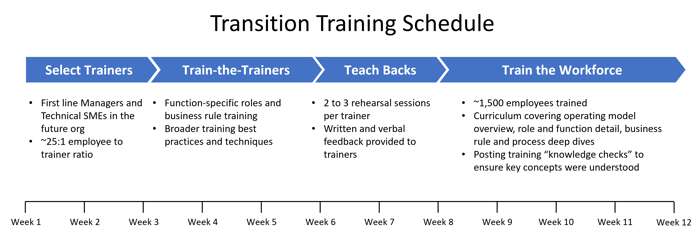Each of the business units executed their mission with very different roles, business processes, and personnel skill levels. In addition, the existing operating model of each business unit had remained unchanged for several decades and the current workforce was very long tenured. As a result, the training effort needed to effectively make the case for change to the workforce while also addressing skill gaps and driving standardization.
The transformation schedule required the geographically dispersed workforce of over 1,500 to be trained within a 90-day period. Without a formal training department, the effort fell to local technical experts and supervisors within the business units. However, while experts and supervisors needed to lead the roll-out, most were not familiar with the new operating model and processes.
WP&C used the organization design elements to create transformation toolkits which were validated with members of the workforce and representatives from the unions. Next, WP&C set out to create a scalable training process that could support large, geographically dispersed workforce with the limited resources and time available. To do this, WP&C used a “train-the-trainer” approach to create a cadre of instructors from the current supervisors and technical experts. As WP&C was integral in the design of the new operating model and development of the training materials, we organized and executed training sessions for the trainers where the materials were introduced. After the materials were introduced, WP&C conducted a series “teach backs” where each trainer practiced delivering their materials and responding to potential audience questions.
Due to workforce’s apprehension and resistance to the coming changes, WP&C used a phased approach to deliver the transition training:
- Phase 1: Select and prepare the trainers through intensive train-the-trainer sessions
- Phase 2: Prepare the workforce to receive the training (e.g., continue making the case for change)
- Phase 3: Deliver training through interactive classroom-style instruction

